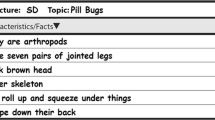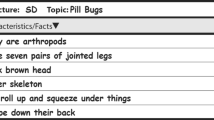Abstract
Teaching children in the primary grades the text structures and features used by authors of information text has been shown to improve comprehension of information texts and provide the scaffolding and support these children need in order to write their own information texts. As teachers implement the English Language Arts Common Core State Standards (CCSS), they will need support and training on how to meet these increased curricular demands. In this article, we describe how children’s information books can be used as exemplars of well-structured text models to teach young students how to write selected discourse patterns required in the CCSS. As children in the primary grades learn to recognize and use well-structured example information texts as models for their own writing, they will be better prepared to deal with less well-structured, more complex text examples in their reading and writing in the years to come.


Similar content being viewed by others
References
Coker, D. (2007). Writing instruction for young children: Methods targeting the multiple demands that writers face. In S. Graham, C. A. MacArthur, & J. Fitzgerald (Eds.), Best practices in writing instruction (pp. 101–118). New York, NY: Guilford.
Common Core State Standards. (2010). National Governors Association and Council of Chief State School Officers. Retrieved April 10, 2012, from http://www.corestandards.org/.
Donovan, C. A., & Smolkin, L. B. (2006). Children’s understanding of genre and writing development. In C. A. MacArthur, S. Graham, & J. Fitzgerald (Eds.), Handbook of writing research (pp. 131–143). New York, NY: Guilford Press.
Eckhoff, B. (1983). How reading affects children’s writing. Language Arts, 60(5), 607–616.
Eckhoff, B. (1986). How basal reading texts affect children’s writing (ERIC Document Reproduction Service No. ED 276969). Urbana, IL: University of Illinois. Retrieved March 30, 2012, from ERIC database.
Hall, K. M., & Sabey, B. L. (2007). Focus on the facts: Using information texts effectively in early elementary classrooms. Early Childhood Education Journal, 35(3), 261–268.
Hall, K. M., Sabey, B. L., & McClellan, M. (2005). Expository text comprehension: Helping primary-grade teachers use expository texts to full advantage. Reading Psychology: An International Quarterly, 26, 211–234.
Kantor, R. N., Andersen, T. H., & Armbruster, B. B. (1983). How inconsiderate are children’s textbooks? Journal of Curriculum Studies, 15, 61–72.
Kim, A., Vaughn, S., Wanzek, J., & St Wei, S. (2004). Graphic organizers and their effects on the reading comprehension of students with LD: A synthesis of research. Journal of Learning Disabilities, 37, 105–118.
Kintsch, W., & Kintsch, E. (2005). Comprehension. In S. G. Paris & S. A. Stahl (Eds.), Current issues in reading comprehension and assessment (pp. 71–92). Mahwah, NJ: Lawrence Erlbaum.
Meyer, B. J. F., & Poon, L. W. (2001). Effects of structure training and signaling on recall of text. Journal of Educational Psychology, 3, 141–159.
Meyer, B. J. F., & Wijkumar, K. (2007). A web-based tutoring system for the structure strategy: Theoretical background, design, and findings. In D. S. McNamara (Ed.), Reading comprehension strategy: Theories, interventions, and technologies (pp. 347–374). Mahwah, NJ: Lawrence Erlbaum.
Nesbit, J. C., & Adesope, O. O. (2006). Learning with concept and knowledge maps: A meta-analysis. Review of Educational Research, 76, 413–448.
Pearson, P. D., & Duke, N. K. (2002). Comprehension instruction in the primary grades. In C. Collins-Block & M. Pressley (Eds.), Comprehension instruction: Research-based best practices (pp. 247–258). New York, NY: Guilford Press.
Read, S., Reutzel, D. R., & Fawson, P. C. (2008). Do you want to know what I learned? Using information trade books as models for teaching young children text structure. Early Childhood Education Journal, 36, 213–219.
Reutzel, D. R., Smith, J. A., & Fawson, P. C. (2005). An evaluation of two approaches for teaching reading comprehension strategies in the primary years using science information texts. Early Childhood Research Quarterly, 20, 276–305.
Shanahan, T., Callison, K., Carriere, C., Duke, N. K., Pearson, P. D., Schatschneider, C., et al. (2010). Improving reading comprehension in kindergarten through 3rd grade: A practice guide (NCEE 2010-4038). Washington, DC: National Center for Education Evaluation and Regional Assistance, Institute of Education Sciences, U.S. Department of Education. Retrieved April 21, 2012, from whatworks.ed.gov/publications/practiceguides.
Smith, M. C. (2000). The real-world reading practices of adults. Journal of Literacy Research, 32, 25–32.
Williams, J. P. (2005). Instruction in reading comprehension for primary-grade students: A focus on text structure. The Journal of Special Education, 39(1), 6–18.
Williams, J. P. (2007). Literacy in the curriculum: Integrating text structure and content area instruction. In D. S. McNamara (Ed.), Reading comprehension strategies: Theories, interventions, and technologies (pp. 199–220). New York, NY: Lawrence Erlbaum.
Williams, J. P., Hall, K. M., & Lauer, K. D. (2004). Building the basics of comprehension instruction: Teaching expository text structure to young at-risk learners. Exceptionality, 12, 129–144.
Williams, J. P., Nubla-Kung, A. M., Pollini, S., Stafford, K. B., Garcia, A., & Snyder, A. E. (2007). Teaching cause-effect text structure through social studies content to at-risk second graders. Journal of Learning Disabilities, 40(2), 111–120.
Williams, J. P., Stafford, K. B., Lauer, K. D., Hall, K. M., & Pollini, S. (2009). Embedding reading comprehension training in content-area instruction. Journal of Educational Psychology, 101(1), 1–20.
Children’s Information Book References
Boothroyd, J. (2010). What holds us to earth?. Minneapolis, MN: Lerner Publishing.
Daronco, M., & Presti, L. (2001). Measuring tools. New York, NY: Benchmark Education.
Fontes, J., & Fontes, R. (2003). A to Z China. New York, NY: Children’s Press.
French, C. (2002). Make an animal mobile. New York, NY: Benchmark Education.
Goodridge, C. (2003). Michelle Kwan. New York, NY: Benchmark Education.
Hammonds, H. (2004). Stars of the show. Austin, TX: Harcourt Achieve Inc.
Kottke, J. (1998). From tadpole to frog. New York, NY: Rosen Book Works, Inc.
Leslie, T. (2005). Divide it up!. New York, NY: Children’s Press.
Miller, G. (2005). Animal tool time. Marlborough, MA: Sundance/Newbridge LLC.
Sipiera, P. (1997). Constellations. New York, NY: Children’s Press.
Sorensen, L. (2008). The national anthem. Vero Beach, FL: Rourke Publishing Co.
Venezia, M. (2001). Edgar Degas. New York, NY: Children’s Press.
Author information
Authors and Affiliations
Corresponding author
Rights and permissions
About this article
Cite this article
Clark, S.K., Jones, C.D. & Reutzel, D.R. Using the Text Structures of Information Books to Teach Writing in the Primary Grades. Early Childhood Educ J 41, 265–271 (2013). https://doi.org/10.1007/s10643-012-0547-4
Published:
Issue Date:
DOI: https://doi.org/10.1007/s10643-012-0547-4




